- April 2 - June 1, 2015
- THE DOOR
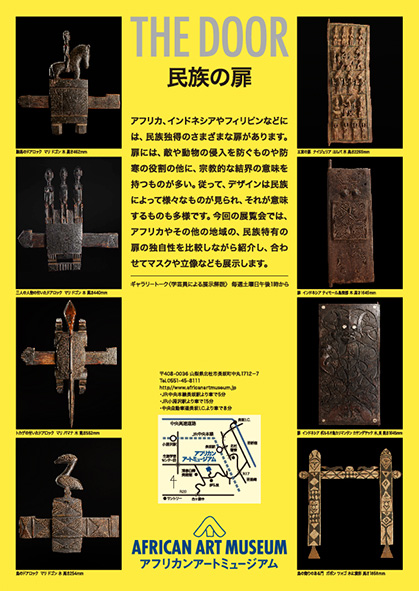
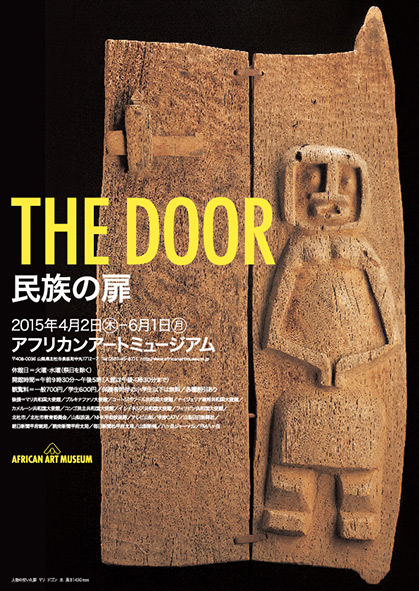
- Ethnically various characteristic doors exist in Africa, Indonesia, Philippine, or others. The majority of doors have a religious meaning of "barrier" besides the purpose of protecting people from animals, their enemies, or cold weathers. Consequently, the variety of designs depending on the people can be seen with diverse meanings on the door. This exhibition compares unique doors in Africa and other countries to introduce their characteristics along with masks and statures.
- Nominal Support: Embassy of the Republic of Cote d'Ivoire, Embassy of the Federal Republic of Nigeria, Embassy of the Republic of Cameroon, Embassy of the Democratic Republic of the Congo, Embassy of Burkina Faso, Embassy of the Republic of Mali, Embassy of the Republic of Indonesia, Embassy of the Republic of Philippines, Hokuto City, Hokuto City Board of Education, YBS Yamanashi Broadcast, NHK Koufu, Yamanashi Nichinichi Shinbun, The Asahi Shinbun Yamanashi-prefecture, The Mainichi Daily News Yamanashi prefecture, The daily Yomiuri Yamanashi prefecture, Yatsugatake Journal, and FM Yatsugatake.
- October 2 - November 30, 2014
(the second half of the exhibition begins on November 4, 2014) - THE FORMATIVE ART OF SOUL West Africa & East Asia
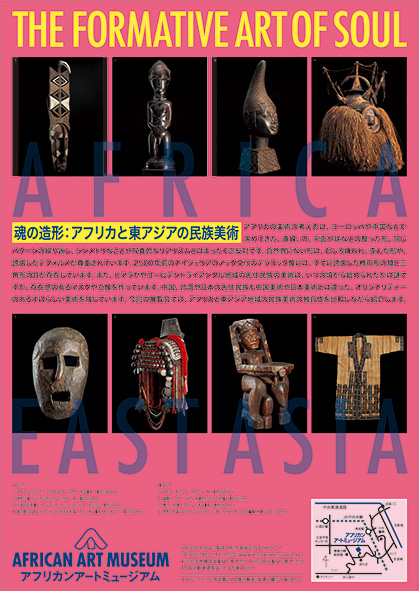
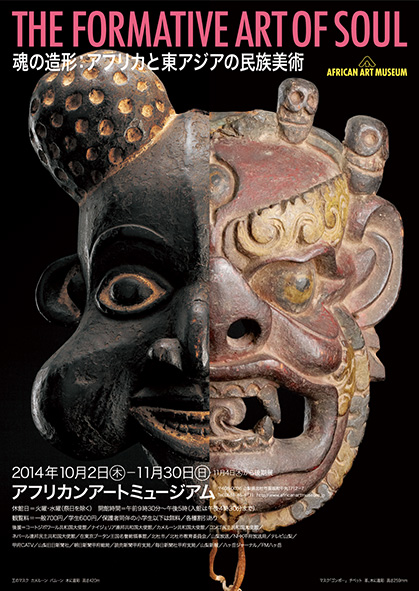
- Perspectives of African art are completely opposite from straight lines, circles, flat or cubic as perfect shapes, repeated patterns, symmetric or realism like a photography which are all pursued in Europe or China. Therefore, these concepts including forms which do not exist in nature are not preferred and even disliked that largely deformed shapes are respected in African art. 2,500 years ago, a terra cotta figure of the Nok culture was created in Nigeria. It has already showed a deformed oval face and triangle eyes. When exactly the art of the people in Himalaya and Golden triangle has begun is mystery. However, they have created remarkable masks and statures. These have left great originalities that differ from art of the native people in China, Taiwan, or Japan, and Chinese or Japanese art. This exhibition introduces African art and the art of the native people in the area of east Asia while comparing characteristics of each art.
- Nominal Support: Embassy of the Republic of Cote d'Ivoire, Embassy of the Federal Republic of Nigeria, Embassy of the Republic of Cameroon, Embassy of the Democratic Republic of the Congo, Royal Bhutanese Embassy, Hokuto City, Hokuto City Board of Education, YBS Yamanashi Broadcast, NHK Koufu, Yamanashi Nichinichi Shinbun, The Asahi Shinbun Yamanashi-prefecture, The Mainichi Daily News Yamanashi prefecture, The daily Yomiuri Yamanashi prefecture, Yatsugatake Journal, and FM Yatsugatake.
- June 5 - September 29, 2014
(the second half of the exhibition begins on August 1, 2014) - Forest Spirit

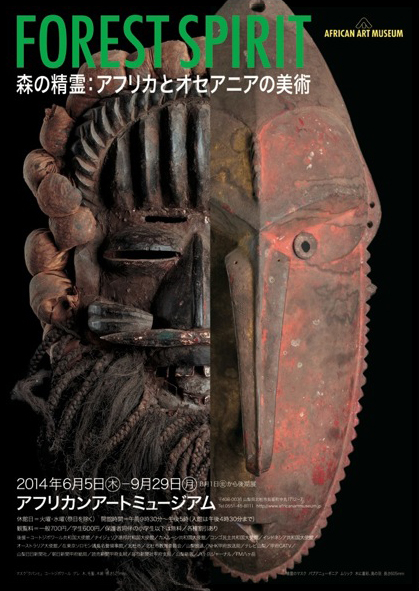
- Images of people wearing masks were drawn on cave walls at Tassili n’Ajjer in south Algeria in 4000BC. These masks are similar to the ones the Gere or Wobe use in the Republic of Cote d’Ivories. Masks, statures, textiles, instruments, or tools created in the deep forest lands of Africa are the arts with characteristic styles which have made though the people's long time belief in animism. Melanesia, Micronesia, and Polynesia are the south pacific region called Oceania. Numberless people have lived these regions so as distinctive cultures and arts have existed. Even though original cultures in Oceania have protected until recently, influences of the civilization have quickly damaged the culture which would lose its originality. This exhibition introduces comparisons between the distinctive arts of Africa and Oceania where deeply surrounded by the forest.
- Nominal support: Embassy of the Republic of Cote d'Ivoire, Embassy of the Federal Republic of Nigeria, Embassy of the Republic of Cameroon, Embassy of the Democratic Republic of Congo, Embassy of the Republic of Indonesia, Embassy of Australia, Honorary consulate of Solomon Islands in Tokyo, Hokuto City, Hokuto City Board of Education, YBS Yamanashi Broadcast, NHK Koufu, Yamanashi Nichinichi Shinbun, The Asahi Shinbun Yamanashi-prefecture, The Mainichi Daily News Yamanashi prefecture, The daily Yomiuri Yamanashi prefecture, Yatsugatake Journal, and FM Yatsugatake.
- April 3, - June 2, 2014
(the second half of the exhibition begins from May 1, 2014) - INVOCATION ART OF WEST AFRICA & SOUTHEAST ASIA

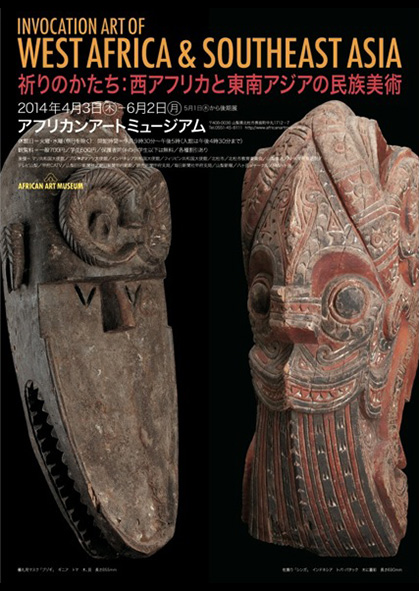
- African masks, statues, textiles, instruments, or tools are the art which has created with characteristic styles through a long held belief in their animism. These arts have inspired and given a large impact to artists including Picasso in the early 20th century. In areas of southeast Asia, various people have different religions and cultures from the ancient Java dynasty. Their arts show distinctive expressions and patterns. Moreover, their textiles have been well known by their sophisticated woven techniques. African Art Museum held "AMAZING SPIRITUAL ART" in 2011. The exhibition introduced arts of the native people in all over the world. However, this exhibition specifies in introducing arts of Mali and Burkina Faso in west Africa, and arts of Indonesia, Malaysia, and Philippines in southeast Asia.
- Nominal support: Embassy of the Republic of Mali, Embassy of Burkina Faso, Embassy of the Republic of Indonesia, Embassy of the Republic of Philippines, Hokuto City, Hokuto City Board of Education, YBS Yamanashi Broadcast, NHK Koufu, Yamanashi Nichinichi Shinbun, The Asahi Shinbun Yamanashi-prefecture, The Mainichi Daily News Yamanashi prefecture, The daily Yomiuri Yamanashi prefecture, Yatsugatake Journal, and FM Yatsugatake.
- October 3 - November 30, 2013
(the second half of the exhibition begins on October 31, 2013) - VARIOUS・IMPRESSION・ART OF CONGO

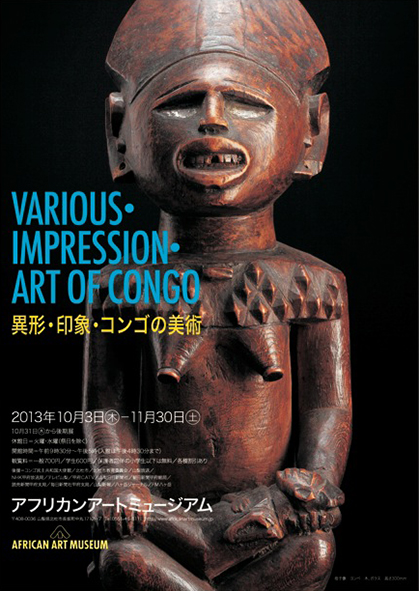
- Democratic Republic of the Congo (D.R Congo) is surrounded by Republic of the Congo in the northwest, Angora in the southwest, Zambia in the south, Tanzania, Burundi, and Rwanda in the east, Uganda and South Sudan in the northeast, and the Central African Republic in the north. The western part of the country bounds on the Atlantic Ocean. The capital of the D.R Congo is Kinshasa. The official name of the country was formerly Zaire. Its land is the second largest in African nations and 11th largest in the world, comparison to the west Europe.
- The Congo kingdom was established in 14th century that the diplomatic relation between the kingdom of Portugal begun in 1485. As a result, the Christian missions was officially approved in the country. While the D.R Congo was becoming a subject state of Portugal until the end of the 19th century, the Kuba kingdom has existed in the country. The kingdom was established by the Kuba people who moved to the southward from the northern region of the country in 16th century. Various sculptural ethnics including the Congo, Yombe, Bembe, Yaka, Teke, Pende, Kuba, Songye, Luba, Hemba, and Lega people live in the D.R Congo where surrounded by the deep forests. They have pursued their own religions and arts. Their masks, statures, instruments, seats, textiles, daily tools were created in characteristics forms. These would approach to viewers and deeply impress our hearts. This exhibition introduces arts of the people in neighboring areas of Republic of Congo, Northern Angola, the former Congo kingdom, and the Kuba kingdom.
- Nominal Support: Embassy of the Democratic Republic of the Congo, Hokuto City, Hokuto City Board of Education, YBS Yamanashi Broadcast, NHK Koufu, Yamanashi Nichinichi Shinbun, The Asahi Shinbun Yamanashi-prefecture, The Mainichi Daily News Yamanashi prefecture, The daily Yomiuri Yamanashi prefecture, Yatsugatake Journal, and FM Yatsugatake.
The Introduction by
The embassy of Democratic Republic of the Congo in Japan

First, we would like to introduce resources and productions of our country. Natural resources of the subsoil in The Democratic Republic of the Congo (referred as D.R Congo) are gold, diamond, copper, uranium, cobalt, oil, tin, or zinc. Moreover, The forest, wood, rubber, or natural park is considered to be our natural resources of the land. Since D.R Congo has freshwater, the hydroelectric energy projects have been the special production of the country.
The relationship between Japan and D.R Congo has begun through a JICA ODA program. Our country has worked with Japan to transfer a technology through training Congolese elites in various areas. In return, D.R Congo has provided the public procurement to Japanese companies in general.
We can say that the Congolese art is very various. The main part of the art is essentially masks of the Kuba, Tsokwe, Pende, or Kongo people. In addition, the Pende people’s dance has been internationally renown as the visual art. In modern time, the Congolese music such as Rumba or Ndombolo is undoubtedly the most dominant art in D.R Congo. It is the pride of the Congo across African nations and all over the world.
What we would like the Japanese to know about D.R Congo is that the country is not only the second largest country in African nations. Beside having rich soil and subsoil, we would like you to know nearly 400 different ethnics live in the country. Therefore, the arts are very diverse. Their arts show a complemental trace which indicates a possible influence of each others. It also explains why the culture in our country is wealthy.
Lastly, we are honored to present you the Congolese art in African Art Museum which we are deeply thankful to. The embassy of Democratic Republic of the Congo trusts that through African Art Museum, this exhibition will allow you to know the Congolese art. Moreover, it is sure to attract some of you to be interested to visit D.R Congo for exploring our beautiful country with such exciting cultural and artistic varieties.
Embassy of the Democratic Republic of Congo
Minister Plenipotentiary Mr. Raphael Mwenda Bambinganila









